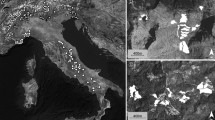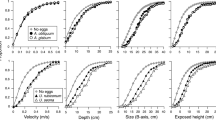Abstract
This study investigates the impact of landscape heterogeneity on community structure and population dynamics in two families of Diptera (Empididae and Chironomidae). Adult emergence is compared with aerial flow by means of emergence traps and yellow traps on a transect across four habitats (pond banks, woodland, grassland and heathland) in close proximity to each other. Empids use different space units according to their larval development, sexual behaviour and food requirements. This creates an intermingling of species and individuals originating from different habitats in the lowest part of the transect. Adult chironomids of aquatic species exhibit a preferential use of open habitats while adults with terrestrial larvae disperse largely above the four sites. Habitat fragmentation and heterogeneity lead to opposite patterns in chironomid distribution: some species disperse over the whole set of macrohabitats but others are confined to a single patch, resulting in population isolation. The impact of spatial and temporal landscape patterning is discussed with a view to community structure, life-history tactics and population dynamics.
Similar content being viewed by others
References
Addicott, F., Aho, J.M., Antolin, M.F., Padilla, D.K., Richardson, J.S. and Soluk, D.A. 1987. Ecological neighborhoods: scaling environmental pattern. Oikos 49: 340–346.
Bailliot, S. and Tréhen, P. 1974. Variations de l'attractivité des pièges colorés de Moericke en fonction de la localisation spatio-temporelle de l'émergence, des comportements sexuels et des phases de dispersion de quelques espèces de Diptères. Ann. Zool. Ecol. Anim. 6: 574–584.
Blanchart, E., Frenot, Y. and Tréhen, P. 1987. Signification biologique du potentiel hydrique dans la distribution des Diptères à larves hydrophiles. Pedobiologia 30: 333–344.
Chvala, M. 1975. The Tachydromiinae (Dipt. Empididae) of Fennoscandia and Denmark. Fauna ent. scand. 3, 360 pp.
Collins, J.E. 1961. British Flies: Empididae (IV). Cambridge University Press.
Crespi, B.J. and Taylor, P.D. 1990. Dispersal rates under variable patch density. Am. Nat. 135: 48–62.
Dale, M.R.T. 1988. The spacing and intermingling of species boundaries on an environmental gradient. Oikos 53: 351–356.
Delettre, Y.R. 1984. Recherches sur les Chironomides à larves édaphiques: biologie, écologie, mécanismes adaptatifs. Thèse Doctorat d'Etat, Univ. Rennes I, 310 pp.
Delettre, Y.R. 1986. La colonisation de biotopes multiples, une alternative à la résistance in situ aux conditions mésologiques défavorables. Cas de Limnophyes minimus (Mg.), Diptère Chironomide à larves édaphiques des landes armoricaines. Rev. Ecol. Biol. Sol. 16: 355–372.
Delettre, Y.R. 1988. Chironomid wing length, dispersal ability and habitat predictability. Holarct. Ecol. 11: 166–170.
Duviard, D. and Blanchet, F. 1983. Studies by trapping of the Empididae (Diptera) of crushed household refuse spread on an Ulex heathland of Central Brittany. Acta Oecologica, Oecol. Applic. 4: 109–122.
Fahrig, L. and Merriam, G. 1985. Habitat patch connectivity and population survival. Ecology 66: 1762–1768.
Harrison, R.G. 1980. Dispersal polymorphisms in insects. Ann. Rev. Ecol. Syst. 11: 95–118.
Hastings, A. 1989. Within-patch dynamics in a metapopulation. Ecology 70: 1261–1266.
Kotliar, N.B. and Wiens, J.A. 1990. Multiple scales of patchiness and patch structure: a hierarchical framework for the study of heterogeneity. Oikos 59: 253–260.
Morris, D.W. 1987. Ecological scale and habitat use. Ecology 68: 362–369.
Pinder, L.C.V. 1978. A key to adult males of the British Chironomidae (Diptera). Freshwat. Biol. Assoc. Sc. Publ. 37, 169 pp. + 189 figs.
Roff, D. 1977. Dispersal in Dipterans: its costs and consequences. J. Anim. Ecol. 46: 443–456.
Southwood, T.R.E. 1977. Habitat, the templet for ecological strategies? J. Anim. Ecol. 46: 337–365.
Southwood, T.R.E. 1988. Tactics, strategies and templets. Oikos 52: 3–18.
Tréhen, P. 1969. Contribution à l'écologie des Empidides. II. Description des différents comportements de vol et de pariade chez plusieurs espèces du genre Hilara Meigen. Rev. Comp. Animal 3: 1–24.
Turner, G.T. 1989. Landscape Ecology: The effect of pattern on process. Annu. Rev. Ecol. Syst. 20: 171–197.
Van Dorp, D. and Opdam, P.F.M. 1987. Effects of patch size, isolation and regional abundance on forest bird communities. Landsc. Ecol. 1: 59–73.
Ward, S.A. 1987. Optimal habitat selection in time-limited dispersers. Am. Nat. 129: 568–579.
Author information
Authors and Affiliations
Rights and permissions
About this article
Cite this article
Delettre, Y., Tréhen, P. & Grootaert, P. Space heterogeneity, space use and short-range dispersal in Diptera: A case study. Landscape Ecol 6, 175–181 (1992). https://doi.org/10.1007/BF00130029
Issue Date:
DOI: https://doi.org/10.1007/BF00130029




